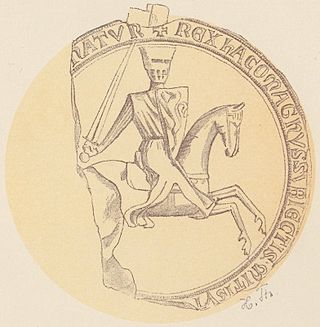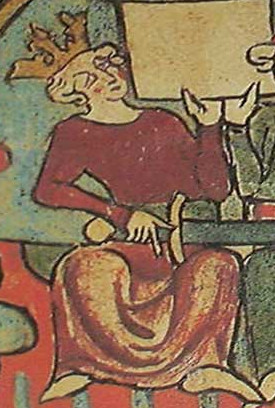
Marie de France was a poet, possibly born in what is now France, who lived in England during the late 12th century. She lived and wrote at an unknown court, but she and her work were almost certainly known at the royal court of King Henry II of England. Virtually nothing is known of her life; both her given name and its geographical specification come from her manuscripts. However, one written description of her work and popularity from her own era still exists. She is considered by scholars to be the first woman known to write francophone verse.
The lais of Marie de France are a series of twelve short narrative Breton lais by the poet Marie de France. They are written in Anglo-Norman and were probably composed in the late 12th century, most likely between 1155-1170. The short, narrative poems generally focus on glorifying the concept of courtly love by the adventures of their main characters. Marie's lais are thought to form the basis for what would eventually become the genre known as the Breton lais. Despite her stature in Anglo-Norman literature and medieval French literature generally, little is known of Marie herself, but it is thought that she was born in France and wrote in England.
A fabliau is a comic, often anonymous tale written by jongleurs in northeast France between c. 1150 and 1400. They are generally characterized by sexual and scatological obscenity, and by a set of contrary attitudes—contrary to the church and to the nobility. Several of them were reworked by Giovanni Boccaccio for the Decameron and by Geoffrey Chaucer for his Canterbury Tales. Some 150 French fabliaux are extant, the number depending on how narrowly fabliau is defined. According to R. Howard Bloch, fabliaux are the first expression of literary realism in Europe.

A Breton lai, also known as a narrative lay or simply a lay, is a form of medieval French and English romance literature. Lais are short, rhymed tales of love and chivalry, often involving supernatural and fairy-world Celtic motifs. The word "lay" or "lai" is thought to be derived from the Old High German and/or Old Middle German leich, which means play, melody, or song, or as suggested by Jack Zipes in The Oxford Companion to Fairy Tales, the Irish word laid (song).

Krákumál or the Lay of Kraka is a skaldic poem, consisting of a monologue in which Ragnar Lodbrok is dying in Ælla's snake pit and looks back at a life full of heroic deeds. It was composed in the 12th century, almost certainly in the Scottish islands. It is composed in a kind of háttlausa in 29 stanzas, most of them with ten lines. Thomas Percy was the first to translate the poem into English.

"Bisclavret" is one of the twelve Lais of Marie de France written in the 12th century. Originally written in French, it tells the story of a werewolf who is trapped in lupine form by the treachery of his wife. The tale shares a common ancestry with the comparable Lay of Melion, and is probably referenced in Sir Thomas Malory's Le Morte d'Arthur with the tale of Sir Marrok, who has a similar story.
Lanval is one of the Lais of Marie de France. Written in Anglo-Norman, it tells the story of Lanval, a knight at King Arthur's court, who is overlooked by the king, wooed by a fairy lady, given all manner of gifts by her, and subsequently refuses the advances of Queen Guinevere. The plot is complicated by Lanval's promise not to reveal the identity of his mistress, which he breaks when Guinevere accuses him of having "no desire for women". Before Arthur, Guinevere accuses Lanval of shaming her, and Arthur, in an extended judicial scene, demands that he reveal his mistress. Despite the broken promise, the fairy lover eventually appears to justify Lanval, and to take him with her to Avalon. The tale was popular, and was adapted into English as Sir Landevale, Sir Launfal, and Sir Lambewell.

Hákonar saga Hákonarsonar or Hákonar saga gamla is an Old Norse Kings' Saga, telling the story of the life and reign of King Haakon Haakonarson of Norway.

The riddarasögur are Norse prose sagas of the romance genre. Starting in the thirteenth century with Norse translations of French chansons de geste and Latin romances and histories, the genre expanded in Iceland to indigenous creations in a similar style.
"Chevrefoil" is a Breton lai by the medieval poet Marie de France. The eleventh poem in the collection called The Lais of Marie de France, its subject is an episode from the romance of Tristan and Iseult. The title means "honeysuckle," a symbol of love in the poem. "Chevrefoil" consists of 118 lines and survives in two manuscripts, Harley 978 or MS H, which contains all the Lais, and in Bibliothèque Nationale, nouv. acq. fr. 1104, or MS S.
"Chaitivel", also known as "Les Quatre Deuils" or "Le Malheureux" in modern French or "The Four Sorrows" in English, is a Breton lai by the medieval poet Marie de France. Chaitivel is the tenth poem in the collection known as the Lais of Marie de France and is one of very few lais to contain alternate titles. Like the other poems in this collection, Chaitivel is written in the Anglo-Norman dialect of Old French, in couplets of eight syllables in length.
Trot is an anonymous Breton lai. It tells the story of a knight who happens upon maidens riding through the forest, and from them, he learns the importance of love.
Nabaret is a short, humorous Breton lai that tells the story of a knight and his vain and prideful wife. With only 48 verses, Nabaret is the shortest of the anonymous lais.
"Doon" is an anonymous Breton lai that tells the story of a knight, Doon, who must pass certain tests to win the hand of a maiden. They marry; but he returns to France alone. He is later reunited with the lady thanks to their grown son, whom he recognizes after dueling him at a tournament. This lai is very similar to "Milun" by Marie de France.
Tyolet is an anonymous Breton lai that takes place in the realm of King Arthur. It tells the tale of a naïve young knight who wins the hand of a maiden after a magical adventure.
Melion is an anonymous Breton lai that tells the story of a knight who transforms into a werewolf for the love of his wife who betrays him.
Strengleikar is a collection of twenty-one Old Norse prose tales based on the Old French Lais of Marie de France. It is one of the literary works commissioned by King Haakon IV of Norway for the Norwegian court, and is counted among the Old Norse Chivalric sagas. The collection is anonymous. It has been attributed to Brother Robert, a cleric who adapted several French works into Norse under Haakon, the best known of which is Tristrams saga ok Ísöndar, but there is also reason to think that the collection may be a gathering of the work of several different translators. Unlike many medieval translations, the Strengleikar are generally extremely close in sense to the Old French originals; the text which differs most is Milun, which is abridged to half its original length.
Uppsala University Library, De la Gardie, 4-7, a thirteenth-century Norwegian manuscript, is 'our oldest and most important source of so-called "courtly literature" in Old Norse translation'. It is now fragmentary; four leaves, once part of the last gathering, now survive separately as AM 666 b, 4° in the Arnamagnæan Collection, Copenhagen.

Graelent is an Old French Breton lai, named after its protagonist. It is one of the so-called anonymous lais.
Desiré is an Old French Breton lai, named after its protagonist. It is one of the so-called Anonymous Lais. It is 'a fairy-mistress story set in Scotland'. Translated into Old Norse, the poem also became part of the Strengleikar, and the translation is relevant to establishing the archetype of the French text.